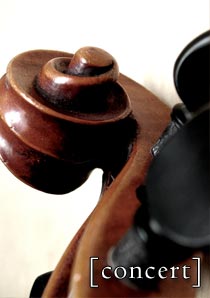Concerto Grosso
for Orchestra, String Quartet, Turntables
| Year Composed: | 2016 |
| Instrumentation: | str qtet + turn. + 2.2.2+bcl.2+cb/4.3.3.1/timp+3 perc/hp/pno/strings |
| Duration | 16 minutes |
| I. | Surface Tension |
| II. | Fusion Dreams |
Program Notes
Achieving genuine musical fusion—the integration of musical genres in a manner that transcends surface interaction—is no simple feat. Fusion is an act of empathy that requires different value systems to be, at the very least, accorded equal respect. Part of how I have chosen to deal with this challenge is to make the challenge itself a part of the discourse. The theatrical component embedded within the first movement (“Surface Tension”) is meant to help articulate the musical drama in a more visceral (and hopefully entertaining) way.
The premise of the first movement is that of an uncomfortable meeting ground between disparate forces. In this arena, the orchestra represents one tradition, the DJ another; the string quartet serves as the intermediary / negotiator between both worlds, having historically interfaced with both. At the outset, the string quartet and DJ participate in a congenial musical dialogue, a continuation of a previously successful rapport. The orchestra then enters, liaising with the string quartet in an equally congenial manner. Things change, however, when the orchestra and DJ first come into contact; both parties are visibly uncomfortable and also dismissive of one another (this should be reflected in the dispositions of the conductor and DJ in particular.) As the movement unfolds, the DJ begins mocking the orchestra; this provokes a defensive response on part of the orchestra, which in turn aggravates the DJ…and so on. By the final section of the movement, the DJ and orchestra have bypassed the peacemaking string quartet and are engaging one another in open hostilities (the quartet, in some sense, has no choice but to ‘join’ the orchestra at this point.) Just as it appears the DJ has the final word (by accelerating the tempo and introducing an invasive drum loop into the final section), the orchestra unleashes its percussion section, effectively silencing the DJ.
The second movement (“Fusion Dreams”) suggests, by contrast, an authentic, even conventional concerto grosso. In this movement, all three forces struggle to put their differences aside; soloists and ensemble alike must extend themselves beyond their natural idioms in an attempt to embody the mutual perspectives of their peers. Christian Petzold’s famous Minuet in G (commonly attributed to Bach) becomes the focal point of a transformative process that all parties can partake in. The movement ends where the first movement began, suggesting a somewhat dream-like and perhaps cyclical journey.
Concerto Grosso for Orchestra, String Quartet, and Turntables is the culmination of a collaborative effort between the Afiara String Quartet, DJ Skratch Bastid, and four composers (including myself) called Spin Cycle. The project, which began with the creation of four original string quartets (Stage 1), evolved into a series of remixes—first by the DJ (Stage 2), then by the composers themselves in response (Stage 3). This concerto represents the fourth stage in this series—a re-re-remix of sorts!—and is best appreciated as an extension of material first presented in my String Quartet No. 3.
Performances
- March 5, 2016 - Toronto Symphony Orchestra, Afiara String Quartet, Skratch Bastid. Roy Thomson Hall, Toronto
Commissions and Awards
- Commissioned by the Toronto Symphony Orchestra.
Reviews
- "I would love to hear the Concerto Grosso again, a piece that galvanized the audience. Lau is a real crowd-pleaser, his music always listenable and often stunningly beautiful, whether in his writing for the quartet or the orchestra. Lau takes us on a wonderful journey...for such a young composer I’m in awe, and eager to hear what comes next from Kevin Lau." - Leslie Barcza, Barczablog

